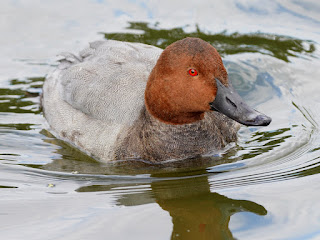Another pair of Goldcrests appeared, this time in a yew tree in the North Flower Walk. Here is one of them.
There was also a Coal Tit. No surprise to find them together again, as both are very small insect-eating birds that like the shelter of evergreens.
Still no further sign of the young Little Owl at the Round Pond. He's now launched on his adult career somewhere in Kensington Gardens and we may not see him again. But the Little Owls have given us a wonderful show this year and all good things must come to an end.
The female Peregrine was on the tower again.
The two latest young Grey Herons at the island, which have been climbing around in the trees for some time, are now exercising their wings before they start trying to fly. They have to get this right, because once they come down they need to be able to fly up again to the nest where their parents feed them.
The pigeon-eating Lesser Black-Backed Gull was near the Dell restaurant with his mate ...
... and a short way along the bank the young gull which is presumably theirs was begging plaintively. They took no notice. It's a big gull now and can do its own scavenging.
The Great Crested Grebe pair at the west end of the island are already in their plain winter plumage.
This afternoon Drew Love-Jones the Wildlife Officer picked up a battered Mute Swan which had clearly lost a fight. We thought it might be the intruding male that nested on the gravel strip on the Long Water and was then ejected by the dominant Long Water swan. But no: when I went by later the intruder family were together by the Triangle car park ...
... and the dominant family were on the gravel.
My guess is that the intruding male is the big bully who usually harasses the other swans at the west end of the Serpentine. Frustrated at being thrown off the Long Water, and even more aggressive than usual because of having cygnets to protect, he vented his feelings by pointlessly beating up another swan that was just minding its own business. The victim in now being looked after and expected to recover.
The Egyptian Goose pair at the Henry Moore sculpture looked down at their own intruder, which is still stubbornly refusing to leave. They have settled down to an uneasy truce, which is quite sensible behaviour by Egyptian standards.
Geese, like gulls, seem to find ropes and cords fascinating. This Greylag poked and chewed the orange plastic rope of a lifebuoy for some time before sitting down to contemplate it.
A Pochard drake cruised by the Vista.
Clumps of pink stonecrop in the Dell are attracting a lot of bees, including this Buff-Tailed Bumblebee.
There are Speckled Wood butterflies all over Kensington Gardens.
Two butterflies outside the park: a Small Copper at Rainham Marshes photographed by Tom ...
... and Nick Abalov's head-on view of a Large White on a cabbage leaf at Down House in Kent, which is where Charles Darwin lived.
And finally two other pictures from elsewhere by Mark Williams, a House Sparrow at the Tower of London, where there is a thriving colony ...
... and a young Blackbird in St James's Park.



%20and%20mate%202022%202a.jpg)
's%20offspring%202022%201a.jpg)







%202022%201a.jpg)
%202022%201a.jpg)
%202022%201a.jpg)
%202022%201a.jpg)































%202022%201a.jpg)






%202022%201a.jpg)

%202022%202a.jpg)